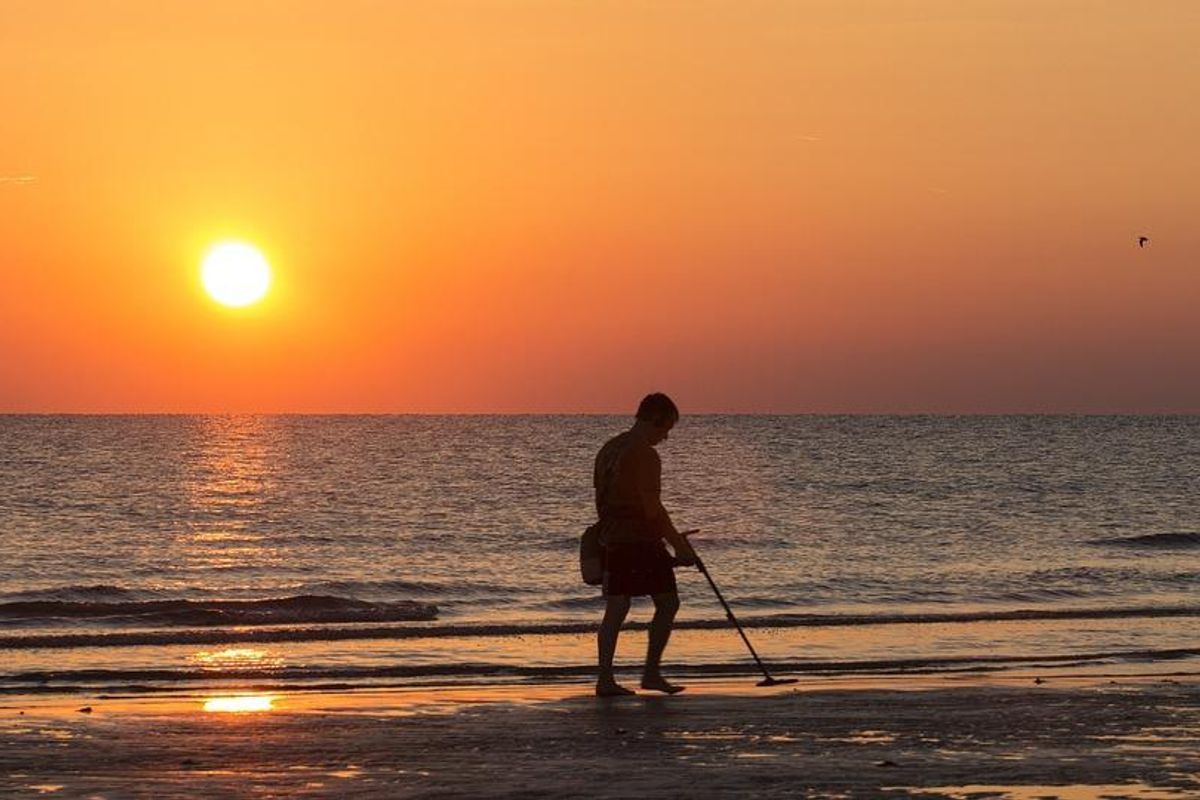After returning a $40K engagement ring, guy with metal detector finds another diamond at the beach
He did what was right and was rewarded.

A metal detector hobbyist looking for treasure on the beach.
Joseph Cook is a popular metal detectorist on social media where he shares videos of the many treasures he finds on Florida beaches. What’s even more engaging than his finds is the incredible excitement he brings to the hobby. It’s like watching Steve Irwin, but with a Florida accent.
Not only is his attitude infectious, but he also makes a point of doing good when he finds lost items. He wears a necklace around his neck with multiple rings that he’s found to remind him of his mission to return lost treasures. In 2022, he told People that he dug up "the biggest diamond I ever found” on the beach. "When I first found it I thought it would just be a nickel, but then I dug it up and it was just this big old diamond and platinum ring," he said.
Even though the diamond ring appeared to be valuable, he had no intentions of keeping or selling the sparkler. He got right to work posting about it on social media and contacted 100 jewelry stores in the area asking if anyone came in asking for a lost ring.
He kept the ring in his scooter until he had it appraised by a local jeweler and found it was worth about $40,000. "Honestly, I had no clue it was even worth that much. I literally put it in my scooter; I thought maybe a grand, two grand or something," Cook told Fox News Business. "It was in my scooter for a week until I took it to a jewelry store to get them to look at it."
Two weeks after finding the ring, Cook received some calls from an unknown number and thought it might be the ring’s owner. The calls were from a husband who claimed it was his wife’s lost engagement ring. His jeweler told him that someone had found a similar ring to the one they had lost.
The man sent Cook pictures to prove his claim was legitimate.
"They were pretty happy. The wife was on a FaceTime call, and she just said, ‘Oh my God, I can’t believe it,’ and then she just started crying," Cook told The New York Post. Three weeks later, he met up with the couple to return the ring.
Based on a quote from the alleged owner of the ring, it went through a lot before it was found by Cook.
"I am still in shock that my engagement ring spent several months in the ocean, churned up by a hurricane and found by YOU!" the ring's alleged owner, Tiffany Howard, wrote on Instagram. "Even more shocking is your persistence in finding me to return it!"
"I really wasn't disappointed that I had to return it," Cook said. "Karma's always good, every time I return an item, I find something better, so I'm happy I could give it back."
Cook’s good deed was a tremendous act of generosity. He could have easily pocketed the ring, pawned it, and made himself a nice chunk of change. But instead, he decided to use his treasure-hunting talents for good and he did all that he could to track down the ring’s owner. When asked if he received a reward he said, "I got nothing."
However, Cook’s belief in metal detecting karma paid off right after he returned the treasure to its rightful owners when he found another diamond ring on the beach. "Karma is real," he wrote on Instagram.
This article originally appeared three years ago.
- A simple 'spoon trick' could help victims discreetly alert authorities ... ›
- Newlywed couple gets their wedding ring back after it was found by a Lego man with metal detector ›
- Guy with a metal detector astonished to find a ring that belonged to the Sheriff of Nottingham ›
- Woman reunited with ring she lost 13 years ago down a toilet - Upworthy ›
- Pittsburgh airport staff heroically finds woman's lost diamond - Upworthy ›
- NY woman finds rare diamond in Arkansas for engagement ring - Upworthy ›

